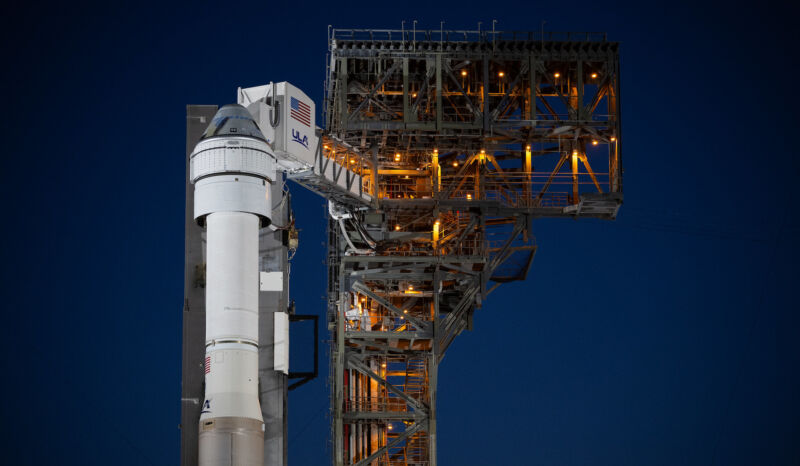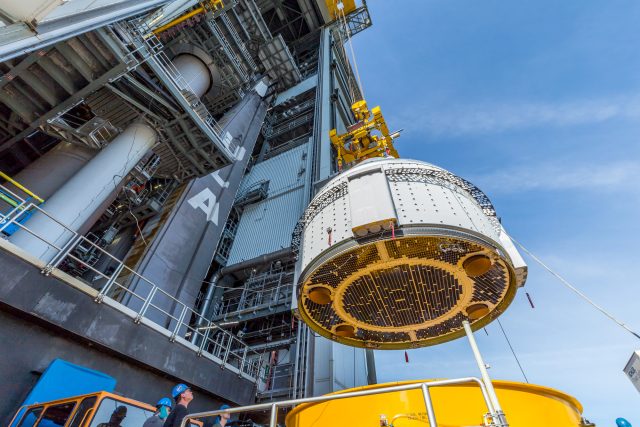
Senior managers from NASA and Boeing told reporters Friday they plan to launch the first crew test flight of the Starliner spacecraft as soon as June 1, following several weeks of detailed analysis of a helium leak and a “design vulnerability” with the ship’s propulsion system.
Extensive data reviews over the last two-and-a-half weeks settled on a likely cause of the leak, which officials described as small and stable. During these reviews, engineers also built confidence that even if the leak worsened, it would not add any unacceptable risk for the Starliner test flight to the International Space Station, officials said.
But engineers also found that an unlikely mix of technical failures in Starliner’s propulsion system—representing 0.77 percent of all possible failure modes, according to Boeing’s program manager—could prevent the spacecraft from conducting a deorbit burn at the end of the mission.
“As we studied the helium leak, we also looked across the rest of the propulsion system, just to make sure we didn’t have any other things that we should be concerned about,” said Steve Stich, manager of NASA’s commercial crew program, which awarded a $4.2 billion contract to Boeing in 2014 for development of the Starliner spacecraft.
“We found a design vulnerability … in the prop (propulsion) system as we analyzed this particular helium leak, where for certain failure cases that are very remote, we didn’t have the capability to execute the deorbit burn with redundancy,” Stich said in a press conference Friday.
These two problems, uncovered one after the other, have kept the Starliner test flight grounded to allow time for engineers to find workarounds. This is the first time astronauts will fly into orbit on a Starliner spacecraft, following two unpiloted demonstration missions in 2019 and 2022.
The Starliner program is running years behind schedule, primarily due to problems with the spacecraft’s software, parachutes, and propulsion system, supplied by Aerojet Rocketdyne. Software woes cut short Starliner’s first test flight in 2019 before it could dock at the International Space Station, and forced Boeing to fly an unplanned second test flight to gain confidence the spacecraft is safe enough for astronauts. NASA and Boeing delayed the second unpiloted test flight nearly a year to overcome an issue with corroded valves in the ship’s propulsion system.
Last year, just a couple of months before it was supposed to launch on the crew test flight, officials discovered a design problem with Starliner’s parachutes and found that Boeing installed flammable tape inside the capsule’s cockpit. Boeing’s star-crossed Starliner finally appeared ready to fly on the long-delayed crew test flight May 6 from Cape Canaveral Space Force Station, Florida.
NASA commander Butch Wilmore and pilot Suni Williams were strapped into their seats inside Starliner on May 6 when officials halted the countdown due to a faulty valve on the spacecraft’s United Launch Alliance Atlas V rocket. ULA rolled the rocket back to its hangar to replace the valve, with an eye toward another launch attempt in mid-May.
But ground teams detected the helium leak in Starliner’s service module in the aftermath of the scrubbed countdown May 6. After some initial troubleshooting, the leak rate grew to approximately 70 pounds psi per minute. Since then, the leak rate has stabilized.
“That gave us pause as the leak rate grew, and we wanted to understand what was causing that leak,” Stich said.
Small problem with big impacts
Boeing engineers traced the leak to a flange on a single reaction control system thruster in one of four doghouse-shaped propulsion pods on the Starliner service module. The spacecraft has 28 of these small control jets to point the spacecraft and make minor adjustments to its orbit. Helium, an inert gas, is not combustible, and is used to pressurize the propulsion system and force hypergolic hydrazine and nitrogen tetroxide propellants through pipes leading to the craft’s maneuvering thrusters.
The most likely culprit for the leak is a defect in a rubber seal about the size of a button on a shirt, where two metal parts of the flange connect. “This particular leak, I don’t think it implicates the design of the seal or the flange, it’s just maybe a defective part,” Stich said.
“This is a high-pressure system, and helium is a very small, tiny molecule, and it tends to leak,” he said.

Managers were faced with two options to address the leak.
In order to repair it, Boeing would need to remove the Starliner spacecraft from its Atlas V rocket and take it back to a nearby facility, where technicians would drain the service module of toxic propellants. There, workers could safely access the leaky seal and install a replacement. Boeing would then have to refill the spacecraft with propellant, reinstall it on the Atlas V rocket, and run the entire vehicle through another series of integrated mechanical and electrical tests. “It would be quite involved,” said Mark Nappi, Boeing’s vice president and program manager for Starliner.
All this would probably take at least several months, and could delay downstream flights to the International Space Station and future ULA missions stacked up behind the Starliner test flight.
Instead, managers decided to take an “analysis-based approach” to understand the leak,” Stich said. Part of this approach included a pressure decay check on Starliner’s propulsion system that ran approximately three days. Engineers detected no helium leaks elsewhere on the spacecraft.
“Not a safety of flight issue”
Boeing and NASA experts also looked at what would happen if the existing leak worsened after launch.
“If this seal completely blows out and we had just metal-to-metal contact, we know we can manage this,” Nappi said. “So this really not a safety of flight issue for ourselves, and we believe that we have a well-understood condition that we can manage.”
Stich said the analysis showed that even if the defective seal failed completely, the spacecraft could handle such an event along with up to four additional helium leaks in other parts of the propulsion system. “With this kind of pressure, it doesn’t take a very big defect to get these kinds of leak rates,” Stich said. “So we think it’s stable. That’s why we think it’ll be fine during ascent and in the rest of the flight.”
As engineers assessed the ramifications of the helium leak, they stumbled upon a design flaw that, in rare cases, could prevent the spacecraft from conducting a braking maneuver to reenter the atmosphere and head for landing at the end of the mission. Boeing designed the spacecraft to perform the deorbit burn three different ways, either with two or four of the ship’s more powerful maneuvering engines, or eight of the smaller reaction control system jets.
Under the wrong set of circumstances, helium manifold failures on two adjacent doghouse propulsion pods could jeopardize Starliner’s ability to execute the deorbit burn.
“It’s a pretty diabolical case, where you would lose two helium manifolds in two separate doghouses, and then they have to be next to each other,” Stich said.
In a matter of weeks, engineers devised a workaround. This new deorbit burn method would require just four reaction control system thrusters. Wilmore and Williams, back at their home base in Houston, tested the new backup mode in a Starliner simulator, according to Stich.
Nappi, who took over management of the Starliner program in 2022, said he isn’t concerned about the robustness of Boeing’s review processes, which missed the design vulnerability in the run-up to the spacecraft’s previous test flights and the first crew launch attempt earlier this month. The design issue also escaped NASA’s oversight reviews.
“We have multiple redundancies in our system,” Nappi said. “We have a case here that’s extremely remote that we missed. And if there are more out there, they’re going to be in that same category of extremely remote.”
With an understanding of the leak and a solution in place for the design problem, NASA and Boeing are moving forward with another Starliner launch attempt June 1. There are additional launch opportunities June 2, June 5, and June 6.
“The teams went under some pretty intense scrutiny to be able to explain the issues that we were finding,” Nappi said. “They got pressure-tested on their conclusions, and then eventually the community bought into our flight rationale and the actions.”
Wilmore and Williams, still in pre-flight medical quarantine, will return to Florida Tuesday for final launch preparations. NASA officials will convene a flight test readiness review Wednesday, and if they give the green light, ULA will roll the Atlas V rocket and Starliner spacecraft back to the launch pad Thursday, May 30.
The Starliner team will check the status of the helium leak during the countdown June 1. If the leak is unchanged, the astronauts will take their seats inside the cockpit to await liftoff at 12:25 pm EDT (16:25 UTC).
Wilmore and Williams will spend at least eight days at the space station before returning to Earth for a parachute-assisted landing in the southwestern United States, likely at White Sands, New Mexico.
Assuming a smooth test flight, NASA hopes to formally clear Starliner for six-month crew rotation flights to the space station next year. NASA will alternate between Boeing’s crew capsule and SpaceX’s Crew Dragon, which has been flying astronauts since 2020, for crew missions to the station.
But NASA and Boeing officials said they are looking at long-term software and hardware fixes to address the newly-discovered design vulnerability in the propulsion system. It’s not yet clear how that might affect the schedule for operational Starliner missions.
